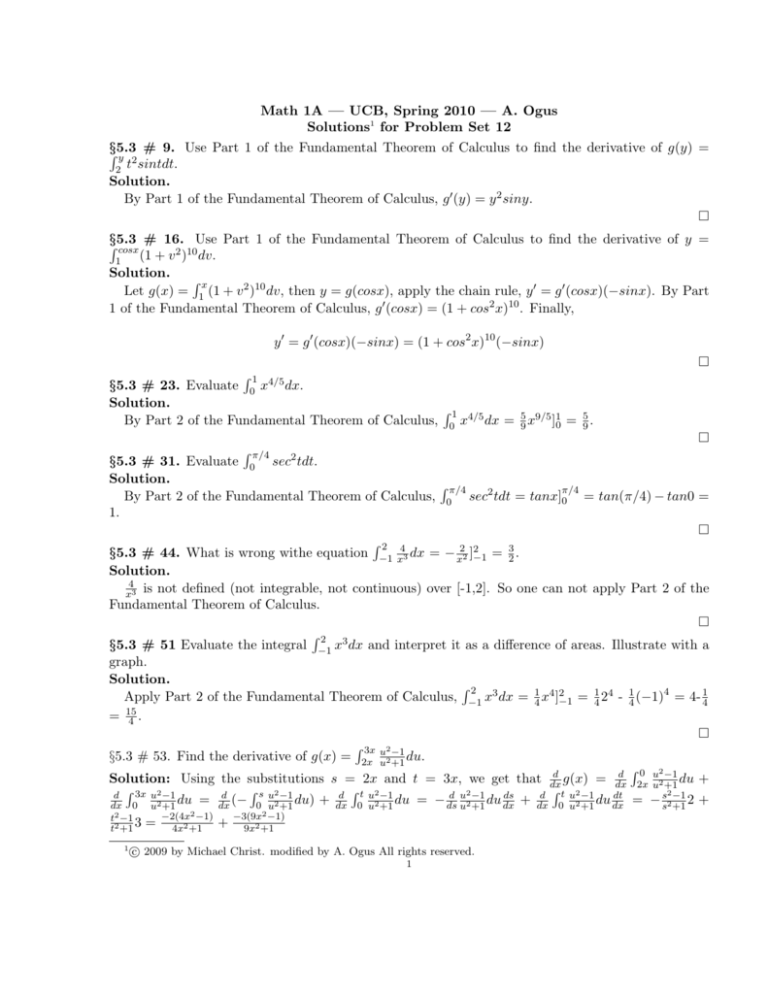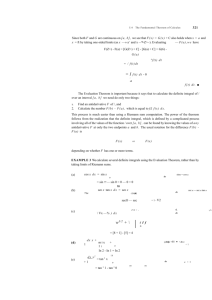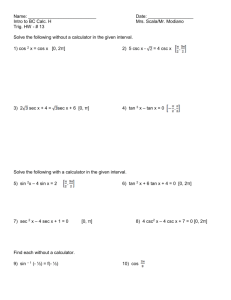
Math 1A — UCB, Spring 2010 — A. Ogus
Solutions1 for Problem Set 12
§5.3
R y 2 # 9. Use Part 1 of the Fundamental Theorem of Calculus to find the derivative of g(y) =
2 t sintdt.
Solution.
By Part 1 of the Fundamental Theorem of Calculus, g 0 (y) = y 2 siny.
§5.3
Use Part 1 of the Fundamental Theorem of Calculus to find the derivative of y =
R cosx # 16.
2 )10 dv.
(1
+
v
1
Solution.
Rx
Let g(x) = 1 (1 + v 2 )10 dv, then y = g(cosx), apply the chain rule, y 0 = g 0 (cosx)(−sinx). By Part
1 of the Fundamental Theorem of Calculus, g 0 (cosx) = (1 + cos2 x)10 . Finally,
y 0 = g 0 (cosx)(−sinx) = (1 + cos2 x)10 (−sinx)
R1
x4/5 dx.
§5.3 # 23. Evaluate 0
Solution.
R1
By Part 2 of the Fundamental Theorem of Calculus, 0 x4/5 dx = 95 x9/5 ]10 = 59 .
R π/4
sec2 tdt.
§5.3 # 31. Evaluate 0
Solution.
R π/4
π/4
By Part 2 of the Fundamental Theorem of Calculus, 0 sec2 tdt = tanx]0 = tan(π/4) − tan0 =
1.
R2 4
§5.3 # 44. What is wrong withe equation −1 x3 dx = − x22 ]2−1 = 32 .
Solution.
4
is not defined (not integrable, not continuous) over [-1,2]. So one can not apply Part 2 of the
x3
Fundamental Theorem of Calculus.
R2 3
§5.3 # 51 Evaluate the integral −1 x dx and interpret it as a difference of areas. Illustrate with a
graph.
Solution.
R2
Apply Part 2 of the Fundamental Theorem of Calculus, −1 x3 dx = 41 x4 ]2−1 = 41 24 - 14 (−1)4 = 4- 14
= 15
4 .
R 3x u2 −1
§5.3 # 53. Find the derivative of g(x) = 2x u2 +1 du.
R 0 u2 −1
d
d
Solution: Using the substitutions s = 2x and t = 3x, we get that dx
g(x) = dx
du +
2
R 3x u2 −1
R s u2 −1
R t u2 −1
R t u2 −1 dt 2x u s+1
2 −1
d
d
d u2 −1
ds
d
d
dx 0 u2 +1 du = dx (− 0 u2 +1 du) + dx 0 u2 +1 du = − ds u2 +1 du dx + dx 0 u2 +1 du dx = − s2 +1 2 +
t2 −1
3
t2 +1
1
=
−2(4x2 −1)
4x2 +1
+
−3(9x2 −1)
9x2 +1
c 2009 by Michael Christ. modified by A. Ogus All rights reserved.
1
R 5x
§5.3 # 56. Find the derivative of y = cos x cos(u2 )du.
Rs
dy
d
Solution: Using the substitutions s = cos x and t = 5x, we get that dx
= dx
(− 0 cos(u2 )du) +
R
R
R
t
s
t
d
d
ds
d
dt
2
2
2
2
2
2
dx ( 0 cos(u )du) = ds (− 0 cos(u )du) dx + dt ( 0 cos(u )du) dx = cos(s ) sin(x)+cos(t )5 = cos(cos x)+
2
5 cos(25x )
Rx
§5.3 # 63. Let g(x) = 0 f (t)dt, where f is the function whose graph is shown (page 389).
(a) At what avlues of x do the local maximum and minimum values of g occur?
(b) Where does g attain its abolute maximum?
(c) On what intervals is g concave downward?
(d) Sketch thegraph of g
Solution: (a) By the fundamental theorem of Calculus, f is the derivative of g, hence local maxima/minima require a point to be critical, i.e. the derivative to be undefined or zero. So only 1, 3, 5, 7
are possible values for local extrema. At 1 and 5, the function g changes from being increasing to
being decreasing, hence we have local maxima. At 3 and 7 the function g changes from being decreasing to being increasing, hence we have local minima.
(b) The absolute maximum can either be achieved at one of the endpoints or at one of the local
R0
maxima. g(0) = 0 f (t)dt = 0. The value g(1) is positive, since it is the area between the graph and
the x-axis integrated from 0 to 1. We have that g(5) > g(1), since the area between the graph and
the x-axis from 1 to 3 is smaller than the area from 3 to 5, so the area we added is bigger than the
area we subtracted when taking the integral. Similarly g(9) > g(5), which makes x = 9 the absolute
maximum.
(c) The graph of g is concave downwards, whenever the graph of its derivative, i.e. of f , is decreasing.
Thus on (0.5, 2) and (4, 6) and (8, 9).
(d) See page A90
§5.3 # 65. Evaluate the limit by recognizing the sum as a Riemann sum for a function defined on
3
[0, 1]. limn→∞ Σni=1 ni 4 .
3
Solution: ∆x = n1 . Thus Rn = Σni=1 ni 4 =
R1
3
limn→∞ Σni=1 ni 4 = 0 x3 = 14 x4 ]10 = 41
i 3
1 n
n Σi=1 ( n ) .
So the function is f (x) = x3 . So the limit is
§5.3 # 66. Evaluate
the sum as a Riemann sum for a function defined on
q theqlimit by recognizing
q
1
1
2
1
[0, 1]. limn→∞ n ( n + n + ... + n ).
R1√
√
3
Solution: ∆x = n1 . So f (x) = x and the limit is just 0 x = 23 x 2 ]10 = 23
R h(x)
d
§5.3 # 68. If f is continuous and g and h are differentiable functions, find a formula for dx
g(x) f (t)dt
R h(x)
R g(x)
R h(x)
d
d
d
0
Solution: dx g(x) f (t)dt = dx − 0 f (t)dt + dx 0
f (t)dt = −f (g(x))g (x) + f (h(x))h0 (x)
§5.3 # 74. The area B ios three
R a times the area labeled
R aA. Express b in terms of a.
Solution: We have that 3 0 ex dx = 3A = B = 0 ex dx. Thus, 3(ea − e0 ) = eb − e0 by the
fundamental theorem of calculus. Thus, eb = 3ea − 2. Thus b = ln(3ea − 2).
√
R
§5.4 # 1. Verify by differentiation that √xx2 +1 dx = x2 + 1 + C.
Solution.
1
dp 2
1
d 2
1
x
x + 1 + C = (x2 + 1)− 2 ·
(x + 1) = √
· 2x = √
2
2
dx
2
dx
2 x +1
x +1
2
§5.4 # 11. Find
Solution.
Z
√
x3 +2 x
R
x
dx.
√
1
Z
√
x3 + 2 x
2
x2
x3
x3
2
dx = x + √ dx =
+2 1 +C =
+ 4 x + C.
x
3
3
x
2
R
§5.4 # 16. Find sec x(sec x + tan x)dx. Solution.
Z
Z
Z
Z
sec x(sec x + tan x)dx = sec2 x + sec x tan xdx = sec2 xdx + sec x tan xdx = tan x + sec x + C
R4
§5.4 # 26. Evaluate 0 (2v + 5)(3v − 1)dv.
Solution.
Z 4
Z 4
13
(2v + 5)(3v − 1)dv =
(6v 2 + 13v − 5)dv = 2v 3 + v 2 − 5v |40 = (128 + 104 − 20) − (0) = 212.
2
0
0
§5.4 # 36. Evaluate
Solution.
R π/3
π/4
sec θ tan θdθ.
Z
π/3
π/4
π/3
sec θ tan θdθ = sec θ |π/4 =
√
2−2
R 3π/2
| sin x|dx.
§5.4 # 44. Evaluate 0
Solution. Since sin x is positive for x between 0 and π, and negative for x between π and 3π/2,
Z 3π/2
Z π
Z 3π/2
| sin x|dx =
sin xdx+
− sin xdx = − cos x |π0 + cos x |π3π/2 = (1)−(−1)+(0)−(−1) = 3.
0
0
π
R2
y 2 )dy.
§5.4 # 47. Find the area of the region pictured by evaluating 0 (2y −
Solution.
Z 2
y3 2
8
4
(2y − y 2 )dy = y 2 −
|0 = (4 − ) − (0) = .
3
3
3
0
R 120
§5.4 # 51. If oil leaks from a tank at a rate of r(t) gallons per minute at time t, what does 0 r(t)dt
represent?
R 120
Solution. 0 r(t)dt is the total amount of oil that has leaked from the tank in the first 120 minutes,
given in gallons.
§5.4 # 52. A honeybee population starts with 100 bees and increases at a rate of n0 (t) bees per
R 15
week, what does 100 + 0 n0 (t)dt represent?
Solution. The total number of bees after 15 weeks.
3
§5.4 # 59. a(t) = t + 4, v(0) = 5, 0 ≤ t ≤ 10. Find (a) the velocity at time t and (b) the distance
travelled.
Solution.
R
R
2
(a) Since velocity is the antiderivative of acceleration, v(t) = a(t)dt = (t + 4)dt = t2 + 4t + C.
We can solve for C using the fact that v(0) = 5,
5 = v(0) = 02 /2 + 4 · 0 + C,
so C = 5 and v(t) =
t2
2
+ 4t + 5 (in m/s).
R 10
(b)The total distance travelled is given by 0 |v(t)|dt. Since v(t) is positive on this interval, we
get
Z 10 2
t
t3
1000
1
( + 4t + 5)dt = ( + 2t2 + 5t) |10
d=
+ 2(100) + 5(10)) − (0) = 583
0 =(
2
6
3
3
0
(in m).
§5.4 # 64. Suppose a volcano is erupting and the readings of the rate r(t) at which solid materials
are spewed into the atmosphere are given by the table. t is in seconds and r(t) is in tonnes/sec. (a)
give upper and lower estimates for the total quantity Q(6) of erupted material after 6 seconds, and
(b) use the midpoint rule to estimate Q(6).
Solution.
(a)Since the numbers for r(t) are increasing with t, the upper estimate will be given by using right
endpoints in a Riemann Sum, and the lower estimate will be given by left endpoints. There are 6
intervals, and each is 1 second long, so the upper estimate is 10 + 24 + 36 + 46 + 54 + 60 = 220 tonnes.
The lower estimate is 2 + 10 + 24 + 36 + 46 + 54 = 172 tonnes.
(b)To use the midpoint rule, we need to know the values of r(t) at the midpoints of our subintervals.
Thus the subintervals cannot be 1 second long (since we do not know the value at the half-seconds), so
we should divide into three 2 second long intervals. Then the Riemann Sum is r(1)·2+r(3)·2+r(5)·2 =
20 + 72 + 108 = 200.
4








